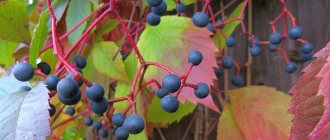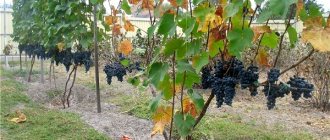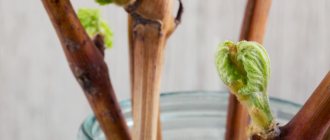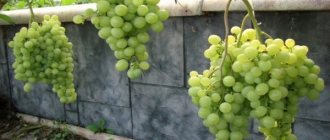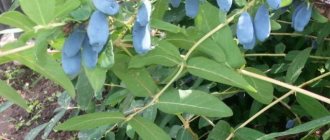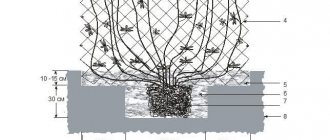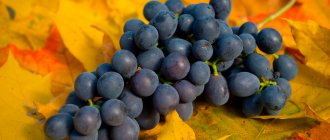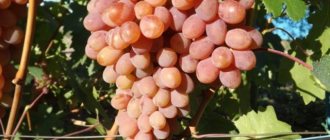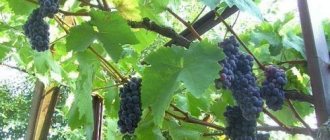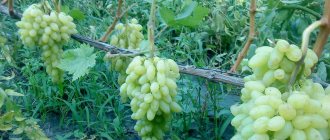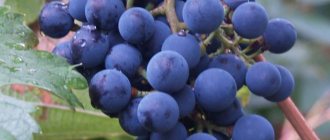Advantages and disadvantages
Advantages:
- High yields.
- Early ripening.
- Ability to be stored for a long time and successfully transported.
- Frost resistance (-25C).
- Easy to care for.
- Pleasant sweet and sour taste with notes of nutmeg.
Flaws:
- The need for systematic pruning of the bush to avoid losses in yield.
- Warming for winter in northern latitudes.
- Reduced yield in stable dry weather (+35C).
Positive and negative properties of the variety
Many gardeners talk about the unpretentiousness of cultivation, and even novice gardeners achieve good yields. An undoubted advantage is the winter hardiness of the plant. The bunches are able to stay on the vine for a long time without losing their external and taste qualities. The benefits of Tukay grapes include:
- stability of high yields;
- unpretentiousness;
- formation of flowers of both sexes;
- ability to withstand difficult transportation conditions;
- versatility of use.
Tips for caring for clerodendrum at home: why doesn’t it bloom and what to do about it?
The plant's unpretentiousness to soil expands the possibilities for planting. The disadvantage is considered to be insufficient resistance to mildew and oidium. When the temperature rises to +35 C, the plant slows down and the yield decreases.
Origin
The hybrid “tukay” is the result of crossing the Hungarian variety “pearl saba” and the Central Asian variety “yakdon”. The “parents” endowed the offspring with precocity, excellent frost resistance and high yields. This successful experiment was successfully implemented by breeders of the Novocherkassk Research Institute named after Ya.I. Potapenko. Other sources claim that the variety was bred by R.F. Sharov, an Altai breeder from the Biysk center of Siberian viticulture.
Parents of “tukaya” – “pearl saba” and “yakdona”
How to properly care for early ripening Tukai grapes
The main techniques to increase the yield of an early-ripening hybrid are irrigating the vineyard, especially the end of May - June, excluding the flowering period; applying organic fertilizers and mineral fertilizers, pruning and cutting off excess shoots and foliage.
Debris and removal of inflorescences
The breaking off of shoots and rationing of bunches is carried out in the spring, since the variety is prone to overloading of inflorescences, which affects the quality of the harvest. When plantings are dense, the foliage of the Tukai hybrid is thinned out. This improves photosynthesis and aeration of the vine. Most often, foliage is removed from the lower part of the bush, since “upper” thinning can cause sunburn on the fruit.
In order to achieve uniform growth of shoots and clusters, improve conditions for pollination and fruit formation, the initial cutting of shoots (bush formation) is carried out in May. At the same time, weak, replacement shoots are carefully broken out (the main and dormant buds remain) on the sleeves and trunk. After 2–3 weeks, when the first inflorescences appear, the main cutting is carried out (pinching and pinching). Double and triple shoots that weaken the bushes and young tendrils that lack a growing point are removed. Shoots are broken off until the internodes become coarse, and there are still 2 weeks left before flowering.
Pinching allows you to remove excess growth and improve the yield
The weak, upper inflorescences on the shoots are removed in favor of the lower ones, leaving 2–4 clusters. In order for strong shoots to develop on the Tukai variety, and the fruits to be large and sweet, thinning of the clusters is carried out even during fruit formation, when the berries are already the size of a pea. This procedure allows you to provide fruiting shoots with nutrients, increase the weight of the bunches and the size of the berries.
Since Tukai is a covering dessert grape, it is often formed in a fan-shaped manner. This approach involves the formation of several powerful shoots (“sleeves”) emanating from the base of a shortened trunk.
Video: debris of extra shoots on grapes (in spring)
Top dressing
Tukai is opened in the spring at a temperature of +10 +12°C and the first leaf treatment is carried out with urea and copper sulfate (according to the instructions).
To improve the formation of ovaries, spray “sheet by leaf” with biological preparations Maxicrop or Ovary. To stimulate fruit growth and improve taste, during flowering the bunches are treated with biostimulants (Benefit) containing amino acids and vitamins. Most often, grapes are fed with boron-containing preparations (Solyubor DF, Vuksal combi B) three times - before, during and after flowering. Many years of experience show that boron improves the fertilization of bunches.
In addition, Tukai, as an agricultural crop, is responsive to organic and mineral fertilizing. In the first year of planting, the vine is not “fed”; in all subsequent years, organic matter must be added - in the spring by directly digging up rotted manure in the near-trunk circle of the grapevine. Root feeding is repeated 3 weeks before flowering. A complex fertilizer containing nitrogen, phosphorus and potassium is applied: 20–25 g of potassium sulfate or potassium salt, 25 g of ammonium nitrate and 50 g of superphosphate are diluted in a bucket of water. Use 200 g of solution per bush and water it generously (6–8 buckets of water).
Nitrogen mineral fertilizers are applied only in the first half of the growing season, potassium fertilizers are required during fruit formation and affect the taste of the berries.
For foliar feeding, which is carried out twice before flowering with an interval of 2 weeks, a superphosphate solution is prepared: 200 g of fertilizer is infused for 24 hours in 1.5 liters of water. Bring the volume to 2 liters, dilute 50 g of potassium sulfate in a separate container. The solutions are combined, brought to 10 liters of water and 15 g of manganese sulfate are added. To prevent the solution from evaporating quickly from the leaves, add 30 g of glycerin and 100 g of sugar. The prepared fertilizer is applied to the leaves using a sprayer in dry, windless weather at the rate of 2–4 liters per 2–3-year-old Tukai bush.
Video: passive feeding of grapes with organic matter (autumn)
Watering
During the growing season, Tukay grapes are watered every month - infrequently, but abundantly to maintain soil moisture levels. Irrigation of the grapevine is usually carried out through a drainage pipe or in trenches dug along the trunk circle (30–40 cm from the trunk) with a depth of 20–30 cm. The amount of water required to effectively moisten the soil depends on the weather and soil composition. Sandy loam soils are watered abundantly - 20-30 l, chernozem and loam - 10-15 l.
Using mulch helps to retain moisture. Drip irrigation in the vineyard allows you to save money, irrigate with settled, warm water and ensures the penetration of liquid to the required depth.
Automatic vineyard watering system saves time and effort
It is not recommended to water grapes during flowering by sprinkling. It is worth remembering that irrigating grape bushes of the Tukai variety with ice water can lead to partial loss of the harvest. To increase frost resistance, organize abundant spring watering. An important point is autumn moisture-recharging watering, which ensures wintering of grapes without problems.
Sheltering grapes for the winter
When Tukay sheds its leaves and the average daily temperature drops to +5°C, the grapevine is treated with a 3% solution of iron sulfate, strengthening the plant’s immunity against mold and fungi. The grapes are cut and bent to the ground; if possible, the branches are wrapped with insulating non-woven material. The perennial vine is placed in a prepared trench (50 cm), insulated with straw or leaves, and covered with spruce branches or branches.
Trenches for wintering grapes and frame shelter
The topmost insulation can be different: slate, wood board, straw, agrofibre, geotextile. If the insulation is not voluminous, it is “pinned” or secured with bricks.
Video: sheltering tall grapes for the winter (one of the methods)
Prevention of grapevine diseases
There is a whole range of measures to combat fungal diseases of grapevines. The Tukai hybrid is most susceptible to infection with powdery mildew and mildew, fusarium and oidium.
Fusarium and oidium are the most common when growing early ripening Tukay grapes
Fungal spores and a group of phytopathogens negatively affect the productivity of Tukay and the quality of berries.
In turn, leaf rollers, mites and thrips also harm agricultural crops and affect the generative organs of the plant.
Thrips are the main pests that attack grapevines.
Targeted complex treatments with chemicals for preventive purposes make it possible to preserve the grape harvest and cause minimal harm to the plant. The procedure is carried out during bud break and on the first leaf using the following drugs: Topaz, Horus, Ridomil Gold MC. Before flowering, the first preventive complex treatment is carried out against the group of powdery mildew diseases with multi-purpose preparations Thanos and Quadris, Decis and Avan, Strobi; again - Ridomil Gold (strictly according to the instructions) . After the initial stage of fruit set, a set of measures is carried out aimed not only at preventing oidium and mildew, but also at combating thrips and mites. Tukay grapes are treated with one of the contact preparations - Talendo, Teovit jet. These drugs allow you to defeat not only harmful insects, but also their larvae.
Spraying grapes against pests and diseases
It is recommended to alternate contact and systemic fungicides so that damaging factors and insects do not become accustomed to the chemical composition of the drug. The treatment is carried out in dry, calm weather.
Main characteristics
Reference! “Tukay” is a table variety that is ideal for fresh consumption. A fragrant compote is also made from the berries of this variety.
Ripening period
The growing season of the “tukai” variety is 90 – 95 days. This allows us to classify it as an ultra-early grape variety. Harvesting most often occurs at the end of July - beginning of August. Also, super early varieties include “super extra”, “rumba”, “Veles” and several other good white and pink varieties.
Bush
The “tukaya” bush is vigorous and spreading. It can reach 1.5 – 3 m in height. Therefore, the winegrower should remember about regular pruning and thinning of the plant. You will also have to take care of a powerful support.
The ovoid, medium-sized leaves have a rich green color and solid edges.
The flowers are bisexual: this allows the plant to safely pollinate itself.
bunches
The clusters of “tukaya” are cylindrical in shape and can “grow” wings. The weight of the hand ranges from 0.7 to 1 kg, and under favorable conditions and proper care it can reach 1.5 kg. The structure of the bunches is medium-dense.
Berries
Each berry is round in shape and light green in color, which gradually acquires an amber tint as it ripens. Weight – 3 – 5 g. The pulp is dense and juicy, the skin is soft, almost unnoticeable when chewing. Sugar level is from 17 to 19% with an acidity of 7 – 9 g/l.
Taste
The fruits of the “tukay” variety have a harmonious taste with very noticeable nutmeg notes and an amazing aroma.
Reproduction of the variety, how and when to do it
The plant can be propagated by cuttings. This is the most popular method. Tukay’s cuttings take root well, so this method of propagation suits him.
It must be propagated either in spring or at the very beginning of summer. This is the time to remove broken or old shoots from grapes. The best of the selected shoots are used for cuttings.
The cutting process can be divided into the following steps:
- Selected shoots are placed in a bucket, they must be sprayed and stored in the basement for one night.
- In the morning you need to take the shoots and cut them into cuttings.
- The resulting cutting must be soaked in water and planted in a box with sand.
- Spray the cuttings and cover with a plastic bag.
- For two weeks, spray the cuttings 5 times a day with warm water - 20-25 degrees.
- After 2 weeks, roots appear, after which it is necessary to spray several times a day.
Features of cultivation
Reference! “Tukai” prefers sandy loam, limestone or loam, well-lit and ventilated areas, watering once a month (in severe drought, once every 15 days) at the rate of 20 - 30 liters per bush, regular fertilizing with organic and complex fertilizers.
Trimming
As a result of spring pruning, no more than 40 - 45 buds should remain on the bush, and no more than 7 on each vine. Experienced winegrowers advise regulating the number of clusters on the vine: there should be no more than 4, while the upper inflorescences must be pinched. This measure will make it possible to ultimately obtain large berries and a high yield. The cuttings remaining after pruning can be successfully used to propagate the variety.
Diseases and pests
“Tukay” is highly resistant to gray rot, but is easily infected with oidium and mildew. To prevent these diseases, the plant needs preventive treatment:
- Bushes should be treated against oidium in early spring and during the period of vigorous foliage development with a solution of copper sulfate.
- Timely thinning of the bushes, sprinkling the soil with ash, mulching the root zone, and irrigating the foliage with a solution of iron sulfate will help save grapes from mildew.
The most dangerous pests are thrips and grape itch. Their appearance can be easily prevented by preventive treatment of the plant with special insecticides: Actellik, Omite, Fufanon.
Option for shelter from the axis of birds - a special net on the bunches
Another threat is birds. Simple “scarers” will help scare them away from the vineyard: a bell, a piece of bright fabric hung on the vines.
Wintering
“Tukay” can withstand frosts of -25ºС. But in northern latitudes with especially harsh winters, winegrowers should not take risks: the vines should be removed from the support, bent to the ground and covered with insulation (agrofibre) and spruce branches. You can sprinkle it with earth.
Harvest storage
Reference! The “tukaya” vine ripens by 85 – 90%. With proper and systematic care, up to 18–20 kg of fruit can be harvested from one grape bush.
“Tukaya” bunches can hang on the bushes for a long time, not only without losing their presentation and taste, but also acquiring an interesting aftertaste.
This variety is perfectly stored until next spring (at a temperature of +1 – +8C). During transportation, the berries do not wrinkle or crack.
Regions
Frost resistance indicators make it possible to successfully grow the variety not only in the southern regions of the country, but also in the Central and Northwestern parts of Russia, as well as in the Urals and Siberia.
Diseases and pests
Among the list of possible crop diseases, Tukai can be affected by mildew and oidium. Therefore, you should not skip the early spring treatment of grape bushes with a solution of copper sulfate and thinning. Then it is recommended to sprinkle the soil with ash powder. If the disease appears, then you should use drugs for fungal infections of grapes, following the manufacturer’s instructions.
The grape variety is susceptible to attacks by thrips, birds and grape itch. Birds must be controlled using repellers or a special net that protects the bush. The remaining pests are destroyed with insectoacaricides. To avoid the spread of parasites, grapes must be inspected regularly.
Comparison with analogues
“Tukay” is one of the earliest varieties that has attractive characteristics for planting on your site. Let's compare it with its main competitors.
| Sign | Variety | |||
| Tukay | Century | Aleshenkin | Julian | |
| Ripening period | 90-100 days | 110-120 days | 100 – 120 days | 100 days |
| Frost resistance | Up to -25 °C | Up to -23 °C | — 26C | Up to -23 °C |
| Yield per bush | up to 20 kg | 30-40 kg | 8 – 10 kg | 30-60 kg |
| Bunches | 700-1000 g | up to 1.5 kg | 350 g – 2 kg | From 800 g to 1.5 kg |
| Taste | Harmonious | Moderately sweet and mild | Harmonious | Sweet with notes of nutmeg and strawberries |
| Color | Green-yellow | Green-yellow | Amber | Light pink with a yellowish tint |
| Disease resistance | Average | Average | Average | High |
| Shelf life | Several months | Few weeks | 1 -2 months | 1-2 months |
| Sugar content | 17-19% | 13-14% | 17 — 20% | 28% |
| Acidity | 7-9 g/l | 5-7 g/l | 3 – 6 g/l | 4-5 g/l |
What are grapes characterized by?
The strengths of the variety are high yields and their stability. The plant makes it possible to obtain tasty fruits in a short time that can be stored for a long time.
Productivity
16-20 kg are removed from one bush. The first harvest is harvested in the 2-3rd year.
Ripening time
Tukai has one of the shortest harvest times. Berries can be harvested 90-100 days after the start of flowering. In cold regions, full ripening is facilitated by the quality of the plant's winter hardiness. The arrival of the first frost is not a critical factor for the plant.
Photo
Below are photos and reviews about the “tukai” variety.
History of selection and region of breeding
The Tukai grape variety was bred by breeders of the VNIIViV named after Ya. I. Potapenko; they also gave the world many other types of grapes, but few of them have such amazing winter hardiness.
Tukay was bred by crossing two species - Yakdona and Zhemchug Saba grape varieties. From them the tukai acquired winter hardiness and the ability to ripen quickly. Thanks to these abilities, the variety can easily be grown not only in the southern part of Russia, but also in the Northwestern and Central parts of the country.
Thus, using the most advanced techniques, Tukai was developed, which these days is becoming increasingly popular among winegrowers. Insufficiently experienced beginners will be interested to know that the variety was the result of the fruitful work of breeders and geneticists of a world-famous institution - VNIIViV named after. ME AND.
Potapenko, located in the city on the Don. Novocherkassk gave the world numerous popular grape varieties. The parents of the Tukai hybrid chose rather non-standard varieties. On the one hand, the earlier ripening of the Central Asian variety “Yakdona” and, on the other hand, the frost resistance of the Hungarian ancient variety “Pearl of Saba”, make it possible to successfully cultivate and obtain good harvests of Tukay not only in the southern regions of Russia, but in the North-West and in the Center of the country, in the Urals and in various regions of Siberia.
Reviews
I have never seen bunches of 800-1200g, at best 300-500g, maybe I was unlucky with pollination, maybe because it was never standardized, although the potential is visible. But the taste is one of my favorites, very good nutmeg. Dmitriy
Pollination is always not very good for me, it peas a little. The Aleshenkin variety is pollinated much worse. It definitely needs to be normalized. Tukay is a variety for itself. The taste is wonderful: fine nutmeg, thin skin, very juicy. Mildew requires a minimum of 4 sprays. Good for northern regions. Tatiana, Belgorod
“Tukay” is a table grape variety of very early ripening. It has excellent taste and attractive appearance. This variety is a true champion for storage and transportation. Berries can be safely transported over long distances, and the fruits can be successfully stored until April next year.
Variety care
Medium or short pruning is used, for 7 eyes; it is better to leave 40-45 buds per bush. Tukai requires rationing because it ties too many tassels. If you leave them all, the berries will be crushed and ripening will be delayed. Therefore, excess shoots are broken off and the clusters are plucked out.
Frost resistance is quite high, the buds can withstand frosts of -25ºС. For winter shelter, spruce branches, cardboard, film and other materials are used. The variety cannot boast of high resistance to oidium and mildew; it requires preventive treatments and periodic inspections.
If the weather is rainy during flowering, pollination may be poor and the ovaries may fall off. The shedding of ovaries in unfavorable years is considered by winegrowers to be the biggest drawback of the described form.
Reproduction
Nurseries most often offer Tukai for sale in grafted form, on phylloxera-resistant Riparia rootstock on Rupestris. Cuttings take root easily, so you can plant it with your own rooted seedlings. The variety adapts well to any soil, except overly wet and saline soils. The brighter and warmer the place intended for the vineyard, the better the vines will grow and the harvest will ripen.
Agrotechnical measures largely depend on where the grapes are grown. If in difficult continental conditions with long cold winters, short summers and strong winds, then it is most effective to use the Siberian system.
Development of willpower. How to cultivate willpower
According to the recommendations, Tukai in the northern regions is initially planted deep. This greatly simplifies the shelter, saving materials, effort and time. In winter, pre-planted and treated vines are covered.
It is necessary to carry out snow retention, because under the blanket of snow the buds will be reliably protected from frost. Trimming in two stages. After harvesting, the weak parts of the plant are removed so that the main shoots have time to ripen. The main pruning is carried out later, before the shelter.
